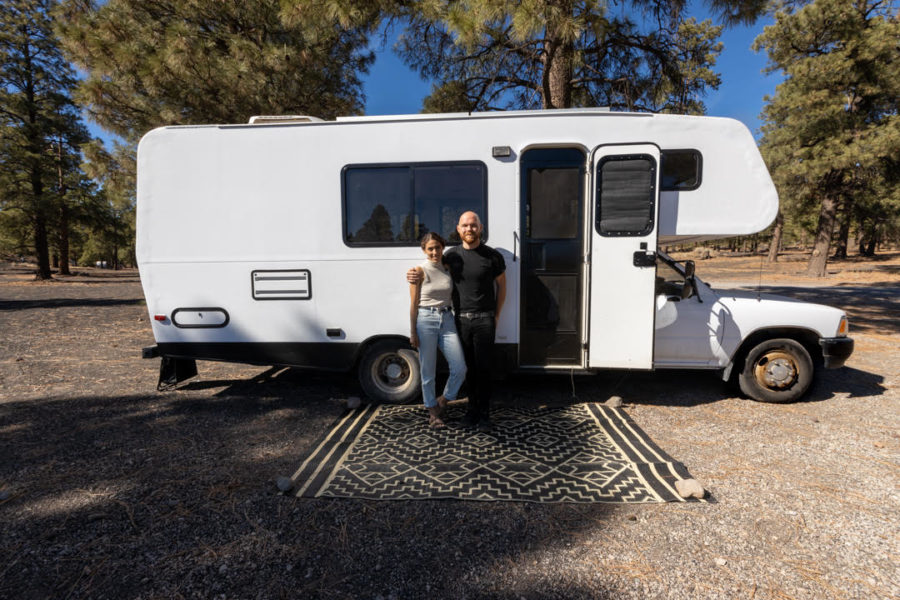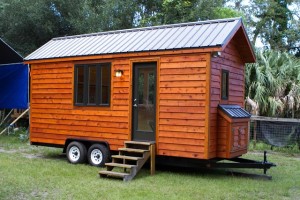This post contains affiliate links.
Jonluc and Jackie took on the awesome project of renovating this 1993 camper that was filled with water damage. It was a challenge to take something meant for transient weekend travel and transform it into a sturdy full-time home. But they did a great job!
Like most Class C travel trailers, their bed is over the cab area. They took out the dated dinette and created slipcovers for the outdated fabrics. They do have a shower but use it for storage. Check out the build below!
Don’t miss other interesting tiny homes like this one – join our FREE Tiny House Newsletter
Thrifted Decor in this Toyota Motorhome Renovation

Images via Tiny Home Tours
They went for a minimalist exterior.

Images via Tiny Home Tours
Water damage meant they had to remove most of the interior.

Images via Tiny Home Tours
VIDEO: DIY Beautifully Renovated 1993 RV
Learn more
Related stories
- Four Years of Fifth Wheel Living in Nashville
- Mom, Dad & 3 Boys Traveling USA in RV for 2+ Years!
- Garcia Casita: Family of 6 and Their RV Renovation
You can share this using the e-mail and social media re-share buttons below. Thanks!
If you enjoyed this you’ll LOVE our Free Daily Tiny House Newsletter with even more!
You can also join our Small House Newsletter!
Also, try our Tiny Houses For Sale Newsletter! Thank you!
More Like This: Tiny Houses | Motorhomes | Interviews | RV Living
See The Latest: Go Back Home to See Our Latest Tiny Houses
This post contains affiliate links.
Natalie C. McKee
Latest posts by Natalie C. McKee (see all)
- Hygge Dream Cottage Near Quebec City - April 19, 2024
- She Lives in a Tiny House on an Animal Sanctuary! - April 19, 2024
- His Epic Yellowstone 4×4 DIY Ambulance Camper - April 19, 2024






small space – done really well – I would need some window coverings though!
RV manufacturers should take a cue from this interior and start making their interiors look more like regular homes instead of using dated swirly fabrics or awful fake wood paneling. And maybe you can upgrade to better fabrics but most of the fabrics and wall materials used in RV’s is weird. And maybe doing what these people did, re-doing an existing but damaged or tired interior, would be a better option. Love the plain exterior, too! RV paint jobs always have trite swoopy patterns (one of my biggest complaints about them) and the plain is easier on the eyes. Time for manufacturers to evolve a bit.
Completely agree.
You made me laugh with the “dated swirly fabrics” commment! It’s so true — what is up with those very specific RV fabric choices?
There’s multiple reasons…
First, mind RV’s are recreational vehicles that will get dirty, will be abused and damaged, will develop issues, and mostly aren’t intended to be used for more than 4 weeks out the year, spending most of the time in storage. So most are designed with that in mind, like dark colors help to hide a lot of sins and let people focus on their recreational activities instead of worrying all the time about the RV.
While making them look residential and really nice is usually reserved for those that are custom built and intended for the high end market… The closest exemptions being entry range Park Model RV’s but they mainly trade off costs that would normally go into RV functionality, like automatic leveling jacks, upgraded suspension systems, etc. and instead put that money into the interior with residential appliances, etc.
Second, most manufacturers don’t sell directly to the public. So most of what they produce is based on what the dealerships are ordering from them as it’s really the dealership that are their customers and they in turn buy what they think will sell to the most people and won’t always order a variety of models. Problem is people’s preferences can vary a lot, so what little does overlap will be a compromise that mainly just has to bother the fewest people…
Third, RV manufacturers are actually always trying to evolve and make themselves stand out from the competition, but their business model with the dealership usually locks them into a set budget that they really can’t deviate from and it’s often a balancing act of what may effect consumer appreciation of their product from what they do and don’t put into them. Since, every design choice will have its trade offs and there’s only so much they can do without changing the price and has to be what the dealership will order from them…
Fourth, all RV’s are hand made on an assembly line. Except for a few like Winnebago that are big enough to manufacture most of what they use, most manufacturers have to get just about everything from 3rd parties and just assemble a product with what they can get… A problem that is especially bad during our present supply chain issues… Add, model series may be changed every few years or so and thus won’t always be up to date or be compatible with the latest trends…
Fifth, the RV market is usually split between the mass market of affordable models that may not have a lot of difference from the basic to deluxe models and the high end luxury models that can have anything the client wants…
Even before the pandemic and present economy issues, trailers/5th wheels/toy haulers typically went well over $100K to have good insulation and high end interior finishes… High End Custom Class B’s usually started over $300K… Custom Class A’s started over $500K, etc. all the way up to the really high end that can even cost over $3 million… Those costs are even higher now.
While even regular RV’s can have inflated prices that can even negate the normal depreciation and choices have become increasingly limited…
End of the day, it’s their bottom line, they produce what they can with the least possible cost, the least labor, can be made and delivered to the dealerships in the least amount of time and at can keep the dealerships ordering more… While most will consider their products disposable, with designed obsolescence, and intend for you to just keep buying more over time, just like smartphones, etc. which is part of why warranties are usually only a few years…
So this usually limits those who want nicer RV’s to either DIY or pay extremely high prices for high end and custom builds, many that make most custom built tiny houses look cheap in comparison.
Obviously, it’s a very different market from the Tiny House market that focuses less on Recreational Usage and more on making homes… Something that can be problematic for those trying to convert RV’s into Tiny Houses as beyond appearance, RV’s aren’t built to be converted into homes… The trailers typically can’t take the additional weight, aren’t designed to handle the weight where a tiny house would put it, and are usually so minimally built that you’d need to completely redo the structure to do a proper conversion…
It of course that doesn’t stop everyone from doing it anyway but there’s a lot of compromises when they do but that all effects what you can most likely expect from these products…